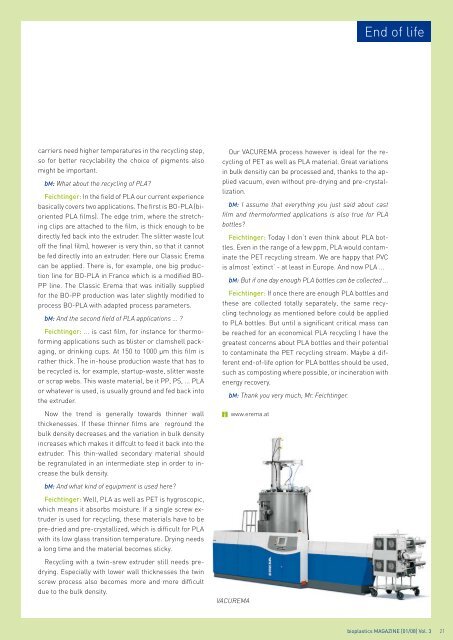01 | 2008
Create successful ePaper yourself
Turn your PDF publications into a flip-book with our unique Google optimized e-Paper software.
End of life<br />
carriers need higher temperatures in the recycling step,<br />
so for better recyclability the choice of pigments also<br />
might be important.<br />
bM: What about the recycling of PLA?<br />
Feichtinger: In the field of PLA our current experience<br />
basically covers two applications. The first is BO-PLA (bioriented<br />
PLA films). The edge trim, where the stretching<br />
clips are attached to the film, is thick enough to be<br />
directly fed back into the extruder. The slitter waste (cut<br />
off the final film), however is very thin, so that it cannot<br />
be fed directly into an extruder. Here our Classic Erema<br />
can be applied. There is, for example, one big production<br />
line for BO-PLA in France which is a modified BO-<br />
PP line. The Classic Erema that was initially supplied<br />
for the BO-PP production was later slightly modified to<br />
process BO-PLA with adapted process parameters.<br />
bM: And the second field of PLA applications ... ?<br />
Feichtinger: ... is cast film, for instance for thermoforming<br />
applications such as blister or clamshell packaging,<br />
or drinking cups. At 150 to 1000 µm this film is<br />
rather thick. The in-house production waste that has to<br />
be recycled is, for example, startup-waste, slitter waste<br />
or scrap webs. This waste material, be it PP, PS, ... PLA<br />
or whatever is used, is usually ground and fed back into<br />
the extruder.<br />
Now the trend is generally towards thinner wall<br />
thickenesses. If these thinner films are reground the<br />
bulk density decreases and the variation in bulk density<br />
increases which makes it diffcult to feed it back into the<br />
extruder. This thin-walled secondary material should<br />
be regranulated in an intermediate step in order to increase<br />
the bulk density.<br />
bM: And what kind of equipment is used here?<br />
Feichtinger: Well, PLA as well as PET is hygroscopic,<br />
which means it absorbs moisture. If a single screw extruder<br />
is used for recycling, these materials have to be<br />
pre-dried and pre-crystallized, which is difficult for PLA<br />
with its low glass transition temperature. Drying needs<br />
a long time and the material becomes sticky.<br />
Recycling with a twin-srew extruder still needs predrying.<br />
Especially with lower wall thicknesses the twin<br />
screw process also becomes more and more difficult<br />
due to the bulk density.<br />
Our VACUREMA process however is ideal for the recycling<br />
of PET as well as PLA material. Great variations<br />
in bulk densitiy can be processed and, thanks to the applied<br />
vacuum, even without pre-drying and pre-crystallization.<br />
bM: I assume that everything you just said about cast<br />
film and thermoformed applications is also true for PLA<br />
bottles?<br />
Feichtinger: Today I don‘t even think about PLA bottles.<br />
Even in the range of a few ppm, PLA would contaminate<br />
the PET recycling stream. We are happy that PVC<br />
is almost ‘extinct’ - at least in Europe. And now PLA ...<br />
bM: But if one day enough PLA bottles can be collected ...<br />
Feichtinger: If once there are enough PLA bottles and<br />
these are collected totally separately, the same recycling<br />
technology as mentioned before could be applied<br />
to PLA bottles. But until a significant critical mass can<br />
be reached for an economical PLA recycling I have the<br />
greatest concerns about PLA bottles and their potential<br />
to contaminate the PET recycling stream. Maybe a different<br />
end-of-life option for PLA bottles should be used,<br />
such as composting where possible, or incineration with<br />
energy recovery.<br />
bM: Thank you very much, Mr. Feichtinger.<br />
www.erema.at<br />
VACUREMA<br />
bioplastics MAGAZINE [<strong>01</strong>/08] Vol. 3 21


















